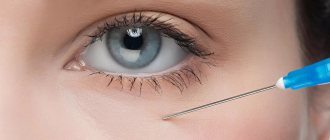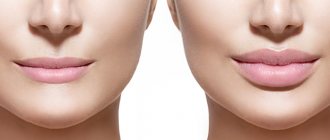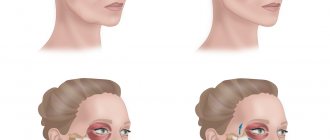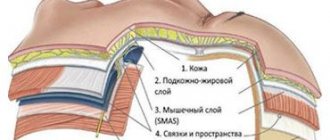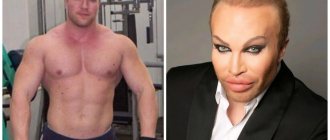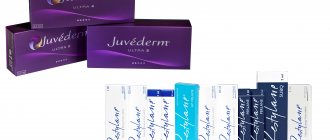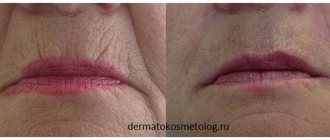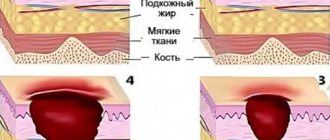Contour plastic surgery with gels using a cannula is the latest, but already proven method in the best clinics in Europe and America. Today it is available in Platinental, in the Moscow and Kazan branches. Its other name is softlifting (from the word soft - soft).
A combination of endoscopic surgical lifting and Radiesse contouring.
By and large, cannulas are the same needles, but very thin, very flexible, smooth, and most importantly, have a blunt, rounded tip (the hole in the cannula is on the side). For what? When a traditional sharp needle hits an obstruction such as a vessel or nerve, it cuts through it. The result is bruising, hematomas, and the need for recovery after the procedure.
This is what a micro cannula for contouring looks like and its tip at multiple magnification.
When the cannula rests on the same obstacle, it carefully bends around it or pushes the tissues apart without injuring them. Therefore, when using cannulas correctly, there is no pain at all (the cannula does not affect pain receptors), bruising or severe swelling.
Contour plastic surgery of cheekbones, corners of the mouth and nasolabial folds with fillers, 3 syringes.
Facial contouring - correction of cheekbones, nasolabial folds, nasolacrimal grooves.
Contour plastic surgery of cheekbones and nasolabial folds.
Contour plastic surgery of the nasolacrimal groove.
Lifting the lower third of the face using fillers.
Contour correction of wrinkles in the ear area, filling in the missing volume of the earlobe.
Male contouring - facial volumization, wrinkle smoothing.
Augmentation of the angles of the lower jaw with fillers.
Botox injections.
But this is not all the advantages of the cannula.
It allows doctors to correct areas previously considered inaccessible in cosmetology: temples, cheekbones, eyebrows, area around the eyes, nose, chin and lower jaw line .
With the help of a cannula, even tightening the skin of the arms and lifting the neck became possible.
Modeling and enlargement of cheekbones with Radiesse. Performed by Dr. Iskornev A.A.
Contouring of cheekbones with fillers.
Comparison of cannula and needle
Cannula | Needle | |
| Pain | – | + |
| Edema | – | + |
| Bruises | – | + |
| Risk of nerve damage | – | + |
| Rehabilitation period | – | + |
Algorithm for working with a cannula
Only a doctor who has undergone special training can perform medical procedures using cannulas.
Important! Unprofessional use of cannulas may cause swelling, damage to blood vessels, or cause the drug to accumulate at the injection sites.
Cannula injection involves the following steps:
- Applying markings to the correction area and marking puncture points.
- Treatment of the affected area with an antiseptic and anesthetic.
- Puncture with a sharp needle.
- Inserting the cannula into the puncture site (the skin should be stretched in the opposite direction).
- Injection of the drug in the corrected area.
- Distribution of the substance using a soft special massage.
Cannulas are used for contouring. However, the difference between a cannula and a needle is that the blunt tip does not allow the active substance to be injected into shallow layers of tissue, as well as making pinpoint injections. In addition, using a cannula, the drug can only be distributed linearly.
Most cosmetologists choose a needle during lip correction procedures. Eliminating wrinkles or scars is also much more convenient with a regular medical needle.
The difference between a needle and a cannula is also the higher price of an instrument with a blunt tip, which increases the cost of the procedure.
The use of cannulas during medical procedures requires appropriate qualifications. In addition, the specialist must make sure that the patient has no contraindications.
It can be assumed that in modern medicine and cosmetology the future lies with the cannula. It has undeniable advantages over the needle. Firstly, it ensures painless injection, secondly, it shortens the rehabilitation period, and thirdly, it allows you to achieve a more natural result after correction.
It is preferable to use a needle when it is necessary to inject the drug into the upper layers of the skin. To achieve maximum effect, you can combine the use of a needle and cannula in one contouring session.
As a result of using softlifting you can:
- get rid of age-related sagging around the eyes, restore volume to the area around the mouth,
- add volume to the temporal area and cheeks,
- eliminate nasolacrimal grooves, marionette lines and other wrinkles,
- make cheekbones higher and fuller, get rid of their age-related flattening,
- tighten the oval of the face, make its contour clear,
- create an ideal lower jaw line,
- and much more.
Expert comment:
“Literally three years ago, such a result could only be achieved through plastic surgery
and facial implants.
The softlifting effect is visible immediately after the procedure and looks completely natural
.
Those of my patients for whom I previously performed needle procedures, after using the cannula, categorically refuse to return to the classic needle technique.”
Iskornev A.A., plastic surgeon.
Types and features of cannulas
Next, let's talk about what types of cannulas are used in modern medicine. This is an unusual instrument that has several varieties.
- Cannulas for contouring
Cosmetologists often choose cannulas for anti-aging manipulations, which help avoid the appearance of hematomas and bruises.
It is also believed that the result of contouring performed using a cannula looks more natural.
- Mini-spike aspiration cannula (flexible Karman cannulas)
A special cannula that is used in surgical gynecology during procedures for vacuum manual aspiration and biopsy of the endometrium of the uterus.
This cannula is equipped with wings and a scale. The material does not contain latex, which eliminates the occurrence of allergies, and the diameter ranges from 3 to 15 mm.
- Nasal oxygen cannula (nasal cannulas)
Non-toxic polyvinyl chloride is used for its production. This type of cannula is used during the procedure of artificial ventilation of the lungs and lavage of the nasal cavity. It is soft and non-traumatic.
- Mini intravenous cannula with injection port for infusion
Used for intravenous administration of drugs. Thanks to the catheter, the cannula can be fixed. Can be used for three days. Made from special medical steel.
We recommend
Laser aesthetic cosmetology: perfect technology for an ideal appearance Read more
- Ophthalmic cannula
Needed to conduct research on the eyeball and administer medications into it. The cannula diameter ranges from 0.5 mm to 1.3 mm with a length from 20 mm to 35 mm. A durable polymer-metal material is used to produce the cannula.
- Tracheotomy cannula
It is used during an operation to create an opening in the trachea for artificial respiration. The cannula is inserted directly into the trachea. Moreover, it can be with or without a cuff.
The cuff is needed to secure the cannula to the skin if it is intended to be worn for a long time. It is also necessary for the procedure of artificial ventilation of the lungs.
In addition to the above classification, cannulas vary in length, diameter, material from which they are made, as well as in the density and consistency of the substance introduced through them, from 21G to 30G.
| Marking | Drug density level | Application |
| 21G | Very tall | It is used to correct aesthetic defects of the lower part of the face, tighten the oval, as well as correct significant congenital defects. Can be used to inject the drug into sensitive areas |
| 22G | High | Used to correct aesthetic imperfections in the middle part of the face, cheeks, and chin |
| 25G | Elevated | Used to correct aesthetic imperfections in the neck, décolleté, and frontal areas |
| 27G | Low and medium | Used for administering the drug to the hands, sensitive areas of the lips and eyelids |
| 30G | Very low | Used for correction of lips, forehead, bridge of the nose and temple area |
Top 8 cannula manufacturers
- "Attica". Produces cannulas for use in otolaryngology. A flexible cannula with a rigid rod is used for washing the middle ear, removing purulent formations and treating otitis media. After insertion, the rod is removed.
- Apexmed. Manufacturer of nasal cannulas used to deliver oxygen through the nasal cavity. Flexible and soft PVC material ensures safety of the nasal mucosa during insertion. Due to the ability to adjust the length, the cannula can be precisely fixed, which increases the ease of use.
- Braun ( Vasofix cannulas) . Makes cannulas for intravenous injections. A special catheter made of polyurethane ensures maximum biological compatibility and makes it possible to carry out long-term medical procedures. The catheter is equipped with a special self-closing valve and wings for better fixation.
- Accu-Chek Flex Link. This manufacturer offers cannulas that are located in a special closed valve. In order to use the cannula, the opening mechanism must be activated. This technology avoids accidental punctures and simplifies disposal of the cannula after use.
- Softfil (“Softfil”). A French manufacturer that has been producing microcannulas for medical cosmetology since 2009. The world-famous company is constantly working on product quality, taking into account the needs of its customers.
All Softfil medical instruments are certified and have the European CE quality mark. Cannulas are made of medical steel.
- Luer Lock. Manufacturer specializing in cannulas for test collection and rapid injections. Such cannulas have special wings for fixation. The needles are made of high-quality medical steel with triangular sharpening.
- Merz Aesthetics. The company has been producing medical cannulas since 2011. The competitive advantage is the use of ultra-thin alloy. This makes inserting the cannula easier and more comfortable.
- TSK Laboratory. World leader in the production of medical products. This Japanese company has been producing needles and cannulas of various modifications for more than 40 years.
Reinforcement of the face with fillers or threads
Facial reinforcement with fillers or threads is not carried out if you feel unwell and have an elevated body temperature.
If the procedure is performed incorrectly, facial asymmetry occurs. The gel may be unevenly distributed under the skin. If the filler injection technique is violated or the doctor’s recommendations are not followed after facial reinforcement, inflammatory processes may develop. If the thread is noticeable under the skin, this also indicates a violation of the lifting technique.
There are moments that you should not be afraid of. This is swelling, redness, bruising after the procedure. These signs may be more or less pronounced, depending on individual characteristics. The redness subsides a couple of hours after the session, the bruises disappear after 2-3 days.
If we are talking about inflammation or displacement of the threads, they need to be removed.
The risk of complications is extremely low. The main advantages of the procedure are:
- Rapidity;
- Minor trauma;
- After the lifting, you can immediately leave the clinic;
- Fast rehabilitation;
- Lower cost compared to surgery.
The result lasts from six months to 7 years, depending on the correction method
If you come across negative reviews about facial reinforcement with fillers, consider several factors:
- The result depends on the individual characteristics of the patient;
- The specialist may not have sufficient qualifications (therefore we pay great attention to the Level of services in our clinic);
- The patient may violate the doctor's instructions after lifting.
Radiesse price
Radiesse is available in disposable sterile filled syringes of various volumes - from 0.8 ml to 3 ml. The choice of syringe volume depends on the type and complexity of the correction. The cosmetologist calculates the final cost of the procedure during a free consultation, after clarifying the patient’s wishes and conducting an examination. For current prices for Radiesse, see our price list.
Make an appointment for a consultation by phone +7-499-110-18-04 or through the form on the website. You can ask your questions to the chief physician of the clinic, Sergei Vladimirovich Tsukor, at
Why us?
Vitality employs only the most qualified cosmetologists who have extensive experience and knowledge in many areas of medicine and facial anatomy. Thanks to this, they can accurately carry out the contouring procedure using cannulas.
In addition, all our offices are equipped with only modern equipment and all the necessary tools, and for rejuvenation, the clinic’s specialists use the most modern drugs of the latest generation, which do not give side effects and are biologically compatible with the tissues of the human body.
Vitality has created a cozy and friendly atmosphere, and doctors surround patients with love, care and attention. Therefore, you will leave us not only beautiful and young, but also in high spirits.
The best cannulas for contouring
There are not so many certified manufacturers on the Russian market. They are more expensive, but if handled correctly, they do not break under the patient’s skin.
SoftFil cannulas
French softfil cannulas are especially loved by cosmetologists. The main difference from competitors is two internal diameters. The sign is the basis for the division into series:
- Classic (wide inner diameter L).
- Precision (extended internal diameter XL without changing the wall strength and flexibility of the cannula).
For ease of filler insertion, a red dot is applied to the base of the cannula, indicating the location of the side hole. There is also a centimeter graduation, which makes it easier to control the movement of the instrument under the skin.
When SoftFil cannulas are packaged with the initial puncture needle, their outer diameters are the same.
SoftFil cannulas of the Classic series have 13 combinations of length and outer diameter, Precision series - 19. The high price is justified by the quality of the alloy, the thoughtfulness of the cannula elements and special comfort in work for the cosmetologist.
Silkann cannulas
Silkann cannulas are chosen by cosmetologists who are accustomed to a “harder” instrument that provides a more precise/targeted placement of filler. The cannulas do not have serrations; the absolutely smooth surface glides easily through any layers of the skin. The base is made of more durable and flexible polycarbonate, which protects the cannula from breaking. To control operation, there is a mark on it in the form of several transverse stripes.
The advertising name “Silkann Silk Cannulas” means surface grinding using “SilkTouch” technology, not silk threads or ceramides in the alloy.
These are premium segment cannulas, one of the most expensive. Cannulas are produced in the UK; 5 types are in greatest demand. If Silkann cannulas are equipped with a puncture needle, its outer diameter will be larger than the diameter of the cannula.
Time Machine Cannulas
The South Korean brand Time Machine produces skin care products (creams, face and body masks). The second direction is tools for cosmetology practice. It was the mesothreads that made the brand recognizable in Russia.
Time Machine cannulas are popular among private cosmetologists, not clinics. The walls are thicker: it is difficult to work with viscous gels. In general, the quality (and therefore smoothness, elasticity) of the metal alloy is worse. But the price is significantly lower than its European counterparts.
What is a cannula?
A cannula in cosmetology is a probe (hollow tube) with a rounded end, made of an elastic, acid-resistant alloy. On the polymer base (which is also called a “cannula”), a thread is formed for screwing into the screw mount of the syringe tip (Luer Lock type).
The outer diameter of the cannula is measured in Gauge, with:
- the larger the size in G, the smaller the diameter in mm;
- Each caliber has a base color (for example, orange for 25 G).
The thicker the cannula, the less likely it is to damage the capillary (although due to the spherical tip it tends to zero).
A wider internal diameter while maintaining the flexibility of the tube and the strength of the cannula walls is a special pride of top manufacturers of medical instruments.
Thus, the SoftFil company (France) produces the Precision series with an internal extended diameter XL and the Classic series with a regular diameter L, TSK Laboratory (Japan) marks cannulas with ultra-thin walls with the UTW symbol. Please note:
they produce cannulas of the same diameter, but of different lengths, so the blister will be marked with the type 30Gx25 mm (needle length 2.5 cm is indicated after the “x”). Additional characteristics are indicated through a slash (manufacturer's cannula SoftFil 22Gx90 mm/L)
Additional markings on the base and on the tube, physical properties (elasticity, surface treatment) depend on the manufacturer.
